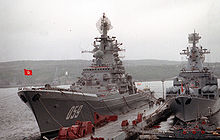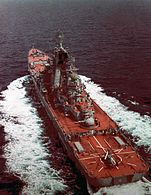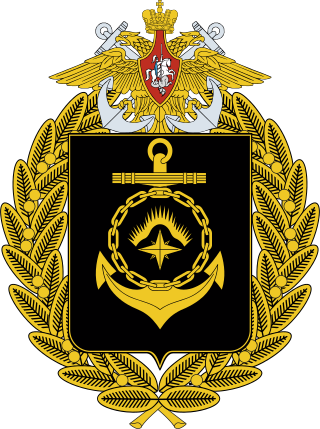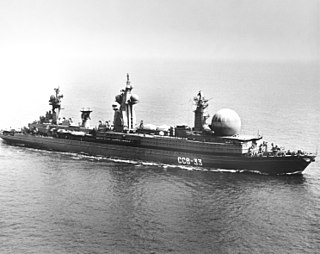History
Originally built for the Soviet Navy, the class is named after the first of a series of four ships constructed, Admiral Ushakov, named Kirov until 1992. Original plans called for construction of five ships. The fifth vessel was planned to be named Fleet Admiral of the Soviet Union Kuznetsov, also referred as Dzerzhinsky. [7] The name was later changed to Oktyabrskaya Revolutsiya (October Revolution), [8] and then just Kuznetsov; [9] but on 4 October 1990, plans for construction of a fifth vessel were abandoned. [7]
The lead ship of the class, Kirov, was laid down in March 1974 at Leningrad's Baltiysky Naval Shipyard, launched on 27 December 1977 and commissioned on 30 December 1980. When she appeared for the first time, NATO observers called her BALCOM I (Baltic Combatant I). Kirov suffered a reactor accident in 1990 during her second deployment, which was in the Mediterranean Sea. Repairs were never carried out due to lack of funds and the changing political situation in the Soviet Union, and she was placed in reserve where she was renamed Admiral Ushakov in 1992. [10] She is presently laid up and was slated to be scrapped in 2021.
Frunze, the second vessel in the class, was commissioned in 1984. She was assigned to the Pacific Fleet. In 1992, she was renamed Admiral Lazarev. The ship became inactive in 1994 and was decommissioned four years later. On 21 February 2021, the Russian Armed Forces and the Russian State Atomic Energy Corporation Rosatom, signed a contract to dismantle and scrap the nuclear powered heavy cruiser. Admiral Lazarev set sail 30 April 2021 for 30th Shipyard. Dismantlement should be completed by 30 November 2025. [11]
Kalinin, now Admiral Nakhimov, was the third ship to enter service, in 1988. She was also assigned to the Northern Fleet. Renamed Admiral Nakhimov in 1992, she was mothballed in 1999 and reactivated in 2005. She is undergoing overhaul and modernization at Severodvinsk Shipyard.
Construction of the fourth ship, Yuriy Andropov, encountered many delays; her construction was started in 1986 but was not commissioned until 1998. She was renamed Pyotr Veliky (after Peter the Great) in 1992. [7] She currently serves as the flagship of Russia's Northern Fleet.
In 1983, a command and control ship, SSV-33 Ural, was launched, although the ship would not be officially commissioned until 1989. She utilized the basic hull design of the Kirov-class vessels, but with a modified superstructure, different armament, and was intended for a different role within the Soviet Navy. Ural was decommissioned and laid up in 2001, due to high operating costs, and scrapped starting in 2010.
On 23 March 2004, English language press reported the Russian Navy Commander-in-Chief, Fleet Admiral Vladimir Kuroedov said Pyotr Veliky's reactor was in an extremely bad condition and could explode "at any moment", a statement which may have been the result of internal politics within the Russian Navy. [12] The ship was sent to port for a month, and the crew lost one-third of their pay.
Russia initially planned to reactivate Admiral Ushakov and Admiral Lazarev by 2020, [2] [13] but it was later indicated that the condition of the reactor cores of both ships was such that it would prove difficult, expensive and potentially dangerous to remove the spent nuclear fuel and repair the cores. As a consequence, both ships were earmarked for scrapping in 2021. [14] The scrapping of Admiral Lazarev began in early 2021. [15]
As of early 2022, only Pyotr Velikiy was operational. Modernization of Admiral Nakhimov is ongoing and was reported, in 2021, to continue until "at least" 2023, [16] with the modernization of Pyotr Velikiy to immediately follow and last for about three years. [17] [18] However, in early 2022, Sevmash CEO Mikhail Budnichenko stated that the ship would be delivered to the Russian Navy in 2022. This deadline would also be missed, and Sevmash later clarified that they expected to return the ship to service in 2024. [19]
The modernization of Admiral Nakhimov and her sister ship is to be extensive, with Admiral Nakhimov expected to receive 174 Vertical-launch (VLS) tubes: 80 for anti-surface and 94 for anti-air warfare, among other upgrades. [20] In early 2022, the Sevmash CEO noted that weapons systems for Admiral Nakhimov would include: the Fort-M (NATO reporting name: SA-N-6 Grumble) and Pantsyr-M (SA-22 Greyhound) air defense systems and Paket-NK and Otvet antisubmarine warfare weapons. It was also reported that the cruiser would potentially be armed with up to 60 3M22 Zircon hypersonic anti-ship missiles. [21]




















